Eyüp Sultan Mosque
The Eyüp Sultan Mosque (Turkish: Eyüp Sultan Camii) is situated in the Eyüp district of Istanbul, outside the city walls near the Golden Horn. The present building dates from the beginning of the 19th century. The mosque complex includes a mausoleum marking the spot where Abu Ayub al-Ansari, the standard-bearer and friend of the Islamic prophet Muhammad, is said to have been buried.
| Eyüp Sultan Mosque | |
|---|---|
 Eyüp Sultan Mosque | |
| Religion | |
| Affiliation | Islam |
| Location | |
| Location | Istanbul, Turkey |
| Geographic coordinates | 41°02′52.61″N 28°56′01.63″E |
| Architecture | |
| Type | Mosque |
| Style | Ottoman architecture |
| Completed | 1458, rebuilt 1800 |
| Minaret(s) | 2 |
History
A mosque complex (külliye) was constructed on the site in 1458 by the Ottoman Turks only five years after the conquest of Constantinople in 1453.[1] By the end of the 18th century the mosque was in a ruinous state, perhaps as a result of earthquake damage, and in 1798 sultan Selim III ordered the whole structure other than the minarets to be pulled down and rebuilt. This work was completed in 1800. The eastern minaret was rebuilt in the original style by Mahmud II in 1822.[2][3]
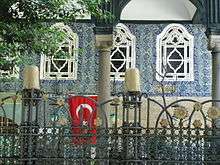
Eyüp Sultan is believed to have died during the first Arab siege of Constantinople in the 670s. His tomb is greatly venerated by Muslims. The mausoleum is on the north side of a courtyard opposite the main entrance to the prayer hall of the mosque.[3]
The mosque was the traditional site for the coronation ceremony of the Ottoman Sultans, where the new sultan was girded with the sword of Osman.[4] The Eyüp Sultan Mosque is Turkey's oldest and most sacred mosque. Its style was changed a couple of times when the Ottomans built it based on their style and architecture during their time, however, when Sultan Selim III took over in the 1800s, he rebuilt the mosque in the Baroque style after an earthquake as previously mentioned.[5] Its new architecture consisted of crystal chandeliers, iznik tiles, and a mixture of different architecture that resembles different time periods. This mosque is next in line of being one of the most important sites for Muslims with Mecca in Saudi Arabia being the first making a significant symbol for Islam. The history behind its name goes back as far as the time of Muhammad where his closest and trustworthy friend was named Eyüp.[5] In addition, this mosque is surrounded by the tombs of significant people that are buried there, which attracts many more Muslims. An important fact that many people confuse is Abu Ayyub al-Ansari's name, which is Eyüp Ensari in Turkish.[6] It was also believed that Abu Ayyub al-Ansari was buried somewhere around the mosque where people had continuously searched for him.[7] In 1458, the tomb was found and the mosque was built next to the tomb. The initiative to build this mosque was during the times of Mehmet the Conqueror where his teacher's dream, Akşemseddin, was to build a mosque in the remembrance and burial place of Eyüp Ensari.[6] Another reason why this mosque is also extremely important for Muslims is due to the reason that the mosque also holds a couple of the personal belongings of Muhammad that have been preserved.[6] One important individual's tomb who is also here belongs to Sokollu Mehmet Paşa.[6] This person was an Ottoman vizier, or chief minister, who served in 1565 under Süleyman the Magnificent and Selim II.[8] Sokollu Mehmet Paşa was also drafted into a child devşirme (collection or gathering in Turkish) and was ranked as one as the highest in the group.[9]
Architecture

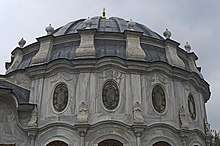

The Eyüp Sultan Mosque was built by the famous Ottoman architect Mimar Sinan. Mimar Sinan was the son of Christian parents who were either Greek or Armenian.[10] He converted to Islam after being drafted into the Janissary corps. His real name before becoming a dedicated Muslim was Joseph, which was a Christian name. Mimar Sinan started developing his talent by helping design and construct military bridges and military buildings where his work did not go unseen. His passion for construction was later honored by making him the chief architect of the Ottoman Empire.[10] He admired the work and artistic style of the Byzantine time period where he got many of his ideas to build other important masterpieces of his time. However, when it was time to build the Eyüp Sultan Mosque, he went with the Baroque style.[10]
Baroque
The word baroque characterizes and illustrates something that is dramatic, highly detailed, or complex. This artistic style started in the 1600s in Rome, Italy where it began to spread from there.[11] After a possible earthquake, Sultan Selim III wanted to rebuild the Eyüp Sultan Mosque using this style that involves motion, drama, high-contrast architecture and design for the mosque. This particular artistic style attempted to portray an atmosphere that appealed and attracted one's emotions and senses where people could almost feel its meaning and significance.[11] The Baroque style from different nations and cultures influenced the Ottoman Empire in many ways. The Ottoman Turks began to adapt many styles from the West and even more artistic taste from Europe where they added a bit of their culture into their new art.[12] The Ottoman Empire were even more excited to continue their existing changes in their style after many foreigners were astonished and impressed by the new architecture, which marked an important time for change in Ottoman architecture.[12] In addition, this time period was greatly influenced by the Baroque style not only through the Ottoman Empire but throughout the world from Europe to the Philippines. Its uniqueness and rare art was what attracted the Ottomans due to its exaggeration involved in the different pieces where people could almost see the art moving. Baroque art was exhibited in all sorts of activities and buildings including religious rituals, opera, churches, palaces, and etc.[13]
Influences
Since the mosque was built during Mehmed the Conqueror's time, this was a time of war where Mehmed was mostly interested in warfare and military related buildings and construction. However, he was involved in many charity projects where he would help the poor with food, but he never took credit for any of his good work. His great grandson, Süleyman the Magnificent, was also an important figure for the mosque due to its rich history with all the many important individuals’ tombs that are found here.[14][15]
Tiles
The wall of the mausoleum facing the mosque has a number of contrasting panels of Iznik tiles. They date from several different periods and were brought together during the reconstruction of mosque in 1798-1799.[16] The walls of the vestibule to the mausoleum are also covered in Iznik tiles. They have the characteristic sealing-wax red slip and date from around 1580.[16] Similar tiles to those in the vestibule are displayed in several museums outside Turkey; they probably once covered the walls of the now demolished entrance hall (camekân) to the baths.[17][18][lower-alpha 1]
The British Museum has a panel of three blue and turquoise Iznik tiles, dating from around 1550, that are similar to some of those that now decorate the external wall of the shrine.[25][26]
Gallery
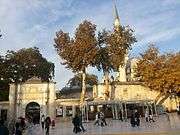 Entrance to the complex
Entrance to the complex Prayer hall and niche (mihrab)
Prayer hall and niche (mihrab) Ablution fountain (şadırvan)
Ablution fountain (şadırvan)- Pulpit (minbar)
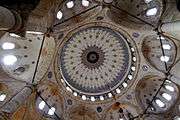 Interior of the dome
Interior of the dome- Mausoleum of Abu Ayyub al-Ansari
 Quranic verse written in Arabic
Quranic verse written in Arabic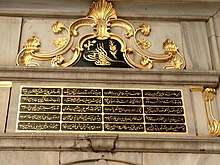 Ottoman calligraphy
Ottoman calligraphy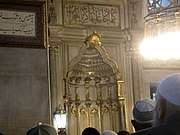 The Mihrab
The Mihrab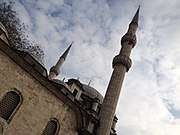 The two Minarets
The two Minarets Water Fountain
Water Fountain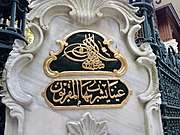 Water Fountain, Quranic Verse in Arabic
Water Fountain, Quranic Verse in Arabic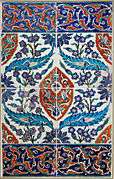 Tiles now in the Louvre in Paris
Tiles now in the Louvre in Paris Tiles now in the British Museum in London
Tiles now in the British Museum in London Gate entrance. Quranic verse written in Arabic (إِنَّمَا يَعْمُرُ مَسَاجِدَ اللَّهِ مَنْ آمَنَ بِاللَّهِ وَالْيَوْمِ الْآخِرِ): "The mosques of Allah shall be visited and maintained by such as believe in Allah and the Last Day"
Gate entrance. Quranic verse written in Arabic (إِنَّمَا يَعْمُرُ مَسَاجِدَ اللَّهِ مَنْ آمَنَ بِاللَّهِ وَالْيَوْمِ الْآخِرِ): "The mosques of Allah shall be visited and maintained by such as believe in Allah and the Last Day"
 Eyup Mosque gate to complex
Eyup Mosque gate to complex Eyup Mosque courtyard with entrance
Eyup Mosque courtyard with entrance Eyup Mosque courtyard with entrance
Eyup Mosque courtyard with entrance Eyup Mosque interior
Eyup Mosque interior
See also
| Wikimedia Commons has media related to Eyüp Sultan Mosque. |
Notes
- The Victoria and Albert Museum in London has a panel of 24 tiles,[18] the Louvre in Paris has a panel of eight tiles,[19] the David Collection in Copenhagen has a tiled panel,[20][21] and the Metropolitan Museum of Art in New York has a single tile.[22] The Calouste Gulbenkian Museum in Lisbon has a panel of 10 tiles.[23][24]
References
- Sumner-Boyd & Freely 2010, p. 363.
- Goodwin 1971, pp. 411-412.
- Sumner-Boyd & Freely 2010, p. 364.
- Goodwin 1971, p. 412.
- Tan, Min Yi. "Eyüp Sultan Mosque - Istanbul". We Love Istanbul. Retrieved 2019-11-20.
- "Eyüp Sultan Mosque & Tombs". Istanbulite. Retrieved 2019-11-20.
- Sevil Derin. "Tarihî Süreçte Eyüp Sultan Camisi | Eyup Sultan Mosque In Historical Process." Sanat Tarihi Dergisi 25, no. 2 (2016): 177-91.
- Şahin, Kaya (2013). Empire and power in the reign of Süleyman : narrating the sixteenth-century Ottoman world. Cambridge and New York: Cambridge University Press. pp. 49–59. ISBN 978-1-107-03442-6.
- "Mehmed Paşa Sokollu | Ottoman vizier". Encyclopedia Britannica. Retrieved 2019-11-20.
- "Sinan | Ottoman architect". Encyclopedia Britannica. Retrieved 2019-11-20.
- "The Baroque Period | Boundless Art History". courses.lumenlearning.com. Retrieved 2019-11-20.
- Rustem, Unver, Necipoglu, Gulru, Eldem, Edhem, Lajer-Burcharth, Ewa, and Roxburgh, David. Architecture for a New Age: Imperial Ottoman Mosques in Eighteenth-Century Istanbul, 2013, ProQuest Dissertations and Theses.
- Snodin, Michael; Llewellyn, Nigel; Norman, Joanna (2009). Baroque, 1620-1800 : style in the age of magnificence. London and New York: London : V & A Pub. : New York : distributed by Harry N. Abrams. ISBN 9781851775583.
- Hickman, William (1978). Mehmed the Conqueror and His Time. New Jersey: Princeton, N.J. : Princeton University Press. pp. 462–465. ISBN 0691099006.
- "Stanford J. Shaw. Between Old and New: The Ottoman Empire under Sultan Selim III, 1789–1807. (Harvard Middle Eastern Studies 15.) Cambridge, Mass.: Harvard University Press. 1971. Pp.xiii, 535. $15.00." The American Historical Review, 1972, The American Historical Review, 4/1/1972.
- Atasoy & Raby 1989, p. 249.
- Sumner-Boyd & Freely 2010, p. 366.
- Victorian & Albert Museum Acc. Num. 401:1 to 24-1900.
- Louvre Museum Acc. Num. OA 3919/2-247e
- Atasoy & Raby 1989, p. 247 fig. 477.
- David Collection Acc. Num. 41/1968
- Metropolitan Museum of Art Acc. Num. 64.27.17
- Calouste Gulbenkian Museum Acc. num. 1709
- Queiroz Ribeiro 2009, p. 119 fig. 68.
- Porter 1995, p. 107, fig. 96.
- British Museum Acc. Num. 1878,1230.534
Sources
- Atasoy, Nurhan; Raby, Julian (1989). Iznik: The Pottery of Ottoman Turkey. London: Alexandra Press. ISBN 978-1-85669-054-6.CS1 maint: ref=harv (link)
- Goodwin, Godfrey (1971). A History of Ottoman Architecture. London: Thames and Hudson. ISBN 0-500-27429-0.CS1 maint: ref=harv (link)
- Porter, Venetia (1995). Islamic Tiles. London: British Museum Press. ISBN 978-0-7141-1456-9.CS1 maint: ref=harv (link)
- Sumner-Boyd, Hilary; Freely, John (2010). Strolling Through Istanbul: The Classic Guide to the City (revised ed.). London: Tauris Parke Paperbacks. ISBN 978-1-84885-154-2.CS1 maint: ref=harv (link)
- Queiroz Ribeiro, Maria (2009). Iznik pottery and tiles in the Calouste Gulbenkian collection. Lisbon: Calouste Gulbenkian Foundation. ISBN 978-972-8848-58-3.CS1 maint: ref=harv (link)
External links
| Wikimedia Commons has media related to Eyüp Sultan Mosque. |

